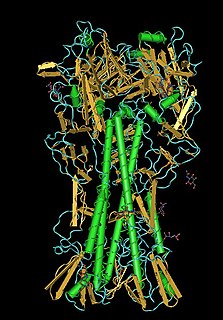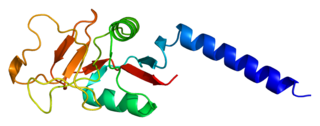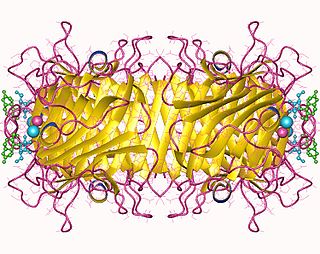Related Research Articles

Lectins are carbohydrate-binding proteins that are highly specific for sugar groups of other molecules. Lectins have a role in recognition on the cellular and molecular level and play numerous roles in biological recognition phenomena involving cells, carbohydrates, and proteins. Lectins also mediate attachment and binding of bacteria and viruses to their intended targets.

The complement system, also known as complement cascade, is a part of the immune system that enhances (complements) the ability of antibodies and phagocytic cells to clear microbes and damaged cells from an organism, promote inflammation, and attack the pathogen's cell membrane. It is part of the innate immune system, which is not adaptable and does not change during an individual's lifetime. The complement system can, however, be recruited and brought into action by antibodies generated by the adaptive immune system.
Pattern recognition receptors (PRRs) play a crucial role in the proper function of the innate immune system. PRRs are germline-encoded host sensors, which detect molecules typical for the pathogens. They are proteins expressed, mainly, by cells of the innate immune system, such as dendritic cells, macrophages, monocytes, neutrophils and epithelial cells, to identify two classes of molecules: pathogen-associated molecular patterns (PAMPs), which are associated with microbial pathogens, and damage-associated molecular patterns (DAMPs), which are associated with components of host's cells that are released during cell damage or death. They are also called primitive pattern recognition receptors because they evolved before other parts of the immune system, particularly before adaptive immunity. PRRs also mediate the initiation of antigen-specific adaptive immune response and release of inflammatory cytokines.
MBL may refer to:

DC-SIGN also known as CD209 is a protein which in humans is encoded by the CD209 gene.

The lectin pathway is a type of cascade reaction in the complement system, similar in structure to the classical complement pathway, in that, after activation, it proceeds through the action of C4 and C2 to produce activated complement proteins further down the cascade. In contrast to the classical complement pathway, the lectin pathway does not recognize an antibody bound to its target. The lectin pathway starts with mannose-binding lectin (MBL) or ficolin binding to certain sugars.

Mannan-binding lectin serine protease 1 also known as mannose-associated serine protease 1 (MASP-1) is an enzyme that in humans is encoded by the MASP1 gene.

Mannan-binding lectin serine protease 2 also known as mannose-binding protein-associated serine protease 2 (MASP-2) is an enzyme that in humans is encoded by the MASP2 gene.
Collectins (collagen-containing C-type lectins) are a part of the innate immune system. They form a family of collagenous Ca2+-dependent defense lectins, which are found in animals. Collectins are soluble pattern recognition receptors (PRRs). Their function is to bind to oligosaccharide structure or lipids that are on the surface of microorganisms. Like other PRRs they bind pathogen-associated molecular patterns (PAMPs) and danger-associated molecular patterns (DAMPs) of oligosaccharide origin. Binding of collectins to microorganisms may trigger elimination of microorganisms by aggregation, complement activation, opsonization, activation of phagocytosis, or inhibition of microbial growth. Other functions of collectins are modulation of inflammatory, allergic responses, adaptive immune system and clearance of apoptotic cells.

Mannose-binding lectin (MBL), also called mannan-binding lectin or mannan-binding protein (MBP), is a lectin that is instrumental in innate immunity as an opsonin and via the lectin pathway.

Complement deficiency is an immunodeficiency of absent or suboptimal functioning of one of the complement system proteins. Because there are redundancies in the immune system, many complement disorders are never diagnosed, some studies estimated that less than 10% are identified. Hypocomplementemia may be used more generally to refer to decreased complement levels while secondary complement disorder means decreased complement levels that are not directly due to a genetic cause but secondary to another medical condition.

Collectin-10, also known as collectin liver 1, is a collectin protein that in humans is encoded by the COLEC10 gene. Its structure is similar to mannan-binding lectin (MBL).

Anti-Saccharomyces cerevisiae antibodies (ASCAs) are antibodies against antigens presented by the cell wall of the yeast Saccharomyces cerevisiae. ASCAs and perinuclear antineutrophil cytoplasmic antibodies (pANCAs) are the two most useful and often discriminating biomarkers for colitis. ASCA tends to recognize Crohn's disease more frequently, whereas pANCA tend to recognize ulcerative colitis.

Protein ERGIC-53 also known as ER-Golgi intermediate compartment 53 kDa protein or lectin mannose-binding 1 is a protein that in humans is encoded by the LMAN1 gene.

The legume lectins are a family of sugar-binding proteins or lectins found in the seeds and, in smaller amounts, in the roots, stems, leaves and bark of plants of the family Fabaceae. The exact function of the legume lectins in vivo is unknown but they are probably involved in the defense of plants against predators. Related proteins in other plant families and in animals have also been found. They have been used for decades as a model system for the study of protein-carbohydrate interactions, because they show an amazing variety of binding specificities and are easy to obtain and purify. Over the years, a quite impressive amount of structural data has been gathered. Well-studied members of this protein family include phytohemagglutinin and concanavalin A.

A C-type lectin (CLEC) is a type of carbohydrate-binding protein domain known as a lectin. The C-type designation is from their requirement for calcium for binding. Proteins that contain C-type lectin domains have a diverse range of functions including cell-cell adhesion, immune response to pathogens and apoptosis.
Mannose-binding lectin-associated protein of 44 kDa (MAp44) is a protein arising from the human MASP1 gene. MASP-1, MASP-3 and MAp44 are alternative splice products of the MASP1 gene. MAp44 has been suggested to act as a competitive inhibitor of lectin pathway activation, by displacing MASP-2 from MBL, hence preventing cleavage of C4 and C2

In molecular biology the L-like lectin domain is a protein domain found in lectins which are similar to the leguminous plant lectins.
Mannan-binding lectin-associated serine protease-2 is an enzyme. This enzyme catalyses the following chemical reaction

Soybean agglutinins (SBA) also known as soy bean lectins (SBL) are lectins found in soybeans. It is a family of similar legume lectins. As a lectin, it is an antinutrient that chelates minerals. In human foodstuffs, it is largely eliminated through fermentation and cooking processes.
References
- ↑ "Mannose-binding lectin deficiency". Genetics Home Reference. U.S. National Library of Medicine.